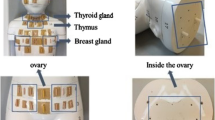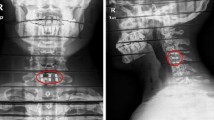Abstract
Objective
To estimate thyroid doses and cancer risk for paediatric patients undergoing neck computed tomography (CT).
Methods
We used average CTDIvol (mGy) values from 75 paediatric neck CT examinations to estimate thyroid dose in a mathematical anthropomorphic phantom (ImPACT Patient CT Dosimetry Calculator). Patient dose was estimated by modelling the neck as mass equivalent water cylinder. A patient size correction factor was obtained using published relative dose data as a function of water cylinder size. Additional correction factors included scan length and radiation intensity variation secondary to tube-current modulation.
Results
The mean water cylinder diameter that modelled the neck was 14 ± 3.5 cm. The mathematical anthropomorphic phantom has a 16.5-cm neck, and for a constant CT exposure, would have thyroid doses that are 13–17 % lower than the average paediatric patient. CTDIvol was independent of age and sex. The average thyroid doses were 31 ± 18 mGy (males) and 34 ± 15 mGy (females). Thyroid cancer incidence risk was highest for infant females (0.2 %), lowest for teenage males (0.01 %).
Conclusions
Estimated absorbed thyroid doses in paediatric neck CT did not significantly vary with age and gender. However, the corresponding thyroid cancer risk is determined by gender and age.
Key Points
• Thyroid doses can be estimated from the CTDI vol in paediatric neck CT .
• Scan length, neck size, and radiation intensity variation should be accounted for.
• Estimated absorbed thyroid doses did not significantly vary with age and gender.
• Thyroid cancer incidence risk is primarily determined by gender and age.






Similar content being viewed by others
Abbreviations
- CTDIvol :
-
Volume CT dose index
- DLP:
-
Dose length product
- AEC:
-
Automatic exposure control
References
Broder J, Fordham LA, Warshauer DM (2007) Increasing utilization of computed tomography in the pediatric emergency department, 2000-2006. Emerg Radiol 14:227–232
Markel TA, Kumar R, Koontz NA, Scherer LR, Applegate KE (2009) The utility of computed tomography as a screening tool for the evaluation of pediatric blunt chest trauma. J Trauma 67:23–28
Blackwell CD, Gorelick M, Holmes JF, Bandyopadhyay S, Kuppermann N (2007) Pediatric head trauma: changes in use of computed tomography in emergency departments in the United States over time. Ann Emerg Med 49:320–324
Brenner DJ, Hall EJ (2007) Computed tomography–an increasing source of radiation exposure. N Engl J Med 357:2277–2284
Almohiy H (2014) Paediatric computed tomography radiation dose: a review of the global dilemma. World J Radiol 6:1–6
Brenner D, Elliston C, Hall E, Berdon W (2001) Estimated risks of radiation-induced fatal cancer from pediatric CT. AJR Am J Roentgenol 176:289–296
Pearce MS, Salotti JA, Little MP et al (2012) Radiation exposure from CT scans in childhood and subsequent risk of leukaemia and brain tumours: a retrospective cohort study. Lancet 380:499–505
Mathews JD, Forsythe AV, Brady Z et al (2013) Cancer risk in 680,000 people exposed to computed tomography scans in childhood or adolescence: data linkage study of 11 million Australians. BMJ 346:f2360
Mettler FA Jr, Wiest PW, Locken JA, Kelsey CA (2000) CT scanning: patterns of use and dose. J Radiol Prot 20:353–359
Yamauchi-Kawaura C, Fujii K, Aoyama T, Koyama S, Yamauchi M (2010) Radiation dose evaluation in head and neck MDCT examinations with a 6-year-old child anthropomorphic phantom. Pediatr Radiol 40:1206–1214
Huda W, Ogden KM (2008) Comparison of head and body organ doses in CT. Phys Med Biol 53:N9–N14
Preston DL, Ron E, Tokuoka S et al (2007) Solid cancer incidence in atomic bomb survivors: 1958-1998. Radiat Res 168:1–64
Huda W, Spampinato MV, Tipnis SV, Magill D (2013) Computation of thyroid doses and carcinogenic radiation risks to patients undergoing neck CT examinations. Radiat Prot Dosim 156:436–444
Huda W, Magill D, Spampinato MV (2011) Technical note: estimating absorbed doses to the thyroid in CT. Med Phys 38:3108–3113
BEIR VII Committee (2005) National Academy of Sciences Committee on the Biological Effects of Ionizing Radiation (BEIR) Report VII. Health Effects of Exposure to Low Levels of Ionizing Radiations, Washington DC
Ron E, Lubin JH, Shore RE et al (1995) Thyroid cancer after exposure to external radiation: a pooled analysis of seven studies. Radiat Res 141:259–277
Schonfeld SJ, Lee C, Berrington de Gonzalez A (2011) Medical exposure to radiation and thyroid cancer. Clin Oncol (R Coll Radiol) 23:244–250
American Association of Physicists in Medicine (2011) Size Specific Dose Estimates (SSDE) in pediatric and adult body CT examinations. In: Report of the AAPM task group 204, College Park, MD.
Christner JA, Braun NN, Jacobsen MC, Carter RE, Kofler JM, McCollough CH (2012) Size-specific dose estimates for adult patients at CT of the torso. Radiology 265:841–847
Israel GM, Cicchiello L, Brink J, Huda W (2010) Patient size and radiation exposure in thoracic, pelvic, and abdominal CT examinations performed with automatic exposure control. AJR Am J Roentgenol 195:1342–1346
American College of Radiology (2012) American College of Radiology Appropriateness Criteria®. American College of Radiology. Available via http://www.acr.org/~/media/ACR/Documents/AppCriteria/Diagnostic/NeckMassAdenopathy.pdf2013
Wippold F, Cornelius R, Berger K et al (2010) ACR appropriateness criteria. Neck Mass / Adenopathy. American College of Radiology
Al-Senan R, Mueller DL, Hatab MR (2012) Estimating thyroid dose in pediatric CT exams from surface dose measurement. Phys Med Biol 57:4211–4221
Mazonakis M, Tzedakis A, Damilakis J, Gourtsoyiannis N (2007) Thyroid dose from common head and neck CT examinations in children: is there an excess risk for thyroid cancer induction? Eur Radiol 17:1352–1357
Acknowledgments
The scientific guarantor of this publication is Maria Vittoria Spampinato. The authors of this manuscript declare no relationships with any companies whose products or services may be related to the subject matter of the article. The authors state that this work has not received any funding. No complex statistical methods were necessary for this paper. Institutional Review Board approval was obtained. Written informed consent was waived by the Institutional Review Board. Methodology: retrospective, cross sectional study, performed at one institution.
Author information
Authors and Affiliations
Corresponding author
Rights and permissions
About this article
Cite this article
Spampinato, M.V., Tipnis, S., Tavernier, J. et al. Thyroid doses and risk to paediatric patients undergoing neck CT examinations. Eur Radiol 25, 1883–1890 (2015). https://doi.org/10.1007/s00330-015-3590-x
Received:
Revised:
Accepted:
Published:
Issue Date:
DOI: https://doi.org/10.1007/s00330-015-3590-x




